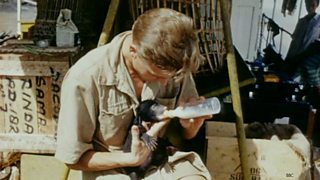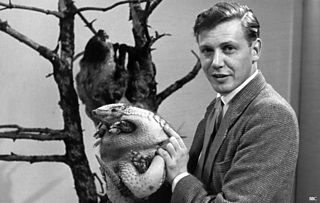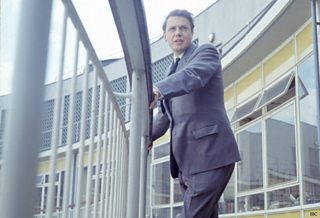
A camera-shy Attenborough feeds a cuddly little bear. Awwwwww....
Sir David Attenborough - celebrating his 90th birthday today - is synonymous with natural history programmes in most people’s minds. But his long career has been more diverse and varied than that.
Following university and National Service, Sir David’s first job was for an educational publisher, but he was unhappy with this work and applied for a job with �������� Radio. He did not get that post, but his application was seen by Mary Adams, head of �������� Television Talks, and he was offered a training course in television production – to his delight, at several times the salary of his publishing job.
Even before he started the course, Sir David was offered the chance to appear on screen, interviewing athlete Gordon Pirie for a programme presented by . Gilbert, a researcher on Picture Page in the 1930s, had risen to be editor and presenter of the post-war, and had branched out into other programmes. In the tiny Alexandra Palace studio, he struggled with the demands of primitive technology. Sir David later discovered that he had been marked down as unsuitable to appear again – because his teeth were too big.
Once his training course was completed, Sir David began work in the Talks Department. He was soon assigned to the long-running , in which a team of experts, among them the colourful Sir Mortimer Wheeler, were challenged to identify and comment on museum exhibits. Sir David’s work on the programme proved successful and by May 1953 he was credited with ‘presenting’ it – in the sense that he produced and directed it in the studio.
Another early show that Sir David produced was , in which musician and song collector Alan Lomax presented folk songs at a time when it was little known genre. Sir David also came up with the short series , hosted by distinguished biologist Julian Huxley, a regular panellist on Animal, Vegetable, Mineral. Sir David himself presented an expanded version of the series under the title in Children’s Television shortly after, his first regular appearance on screen.

In the Lime Grove studio, David Attenborough decorates the Zoo Quest Christmas tree in the usual manner.
As a general talks producer, Sir David was called on to make programmes on various subjects, from painting to books, to ‘tiny things’ in the series . The latter was pre-filmed, which enabled Sir David to start on a new series, requiring him to travel to West Africa as part of an expedition to collect animal specimens mounted by London Zoo.
In the early 1950s it was difficult and expensive to get to that part of the world, and only worthwhile if an extensive trip was made. Sir David was away for three months, and the resultant series was called .
The idea was that Jack Lester, a zoo keeper with experience of Sierra Leone, would find animals, and later show them in the studio, commenting on their notable features and how they were obtained. Filming completed, Zoo Quest began transmitting live on 21 December 1954, but soon ran into a serious problem, when Lester came down with a mystery illness contracted in the tropics.
There was no alternative but for Sir David to present the remaining programmes himself, and it turned out he was a natural broadcaster, with a unique ability to explain and enthral viewers on subjects where he had both knowledge and boundless enthusiasm. A of Zoo Quest soon followed, in which Sir David travelled to British Guiana (now Guyana) in South America.
Sir David was still required to produce more prosaic fare for the Talks Department such as the weekly current affairs discussion In the News. The department also handled Party Political and Ministerial broadcasts, and in 1956 Sir David was assigned to produce Prime Minister Anthony Eden’s appeal to the nation to back him over the Suez crisis, live from 10 Downing Street.
As television expanded in the face of new competition from ITV, empires were being built, with Panorama under Michael Peacock, and (precursor of Tonight), produced by Donald Baverstock. It occurred to Sir David he should have one of his own, which became the Travel and Exploration Unit. It would not cover British wildlife, that being the preserve of the new �������� Natural History Unit started in Bristol by Desmond Hawkins in 1957.
One of its first productions was , which used film produced by explorers and turned it into half-hour travelogues. A third series of Zoo Quest went ahead, one of the most celebrated, in which Sir David travelled to Indonesia in search of, among other things, a . Further Zoo Quests included an expedition to New Guinea to look for , which became a particular interest of Sir David.
In a more anthropological vein he also made , exploring the South Seas and witnessing the vanishing customs and beliefs of people of islands such as Tonga and Vanuatu. One animal star that Sir David was involved in making was , who, along with her protector Joy Adamson, was shown in a programme in 1961; this was filmed as part of the expedition for the last Zoo Quest, to .
Travellers’ Tales had now evolved into the series Adventure, which in 1963 included , Sir David’s own expedition to the Northern Territory of Australia. Sir David also made the studio-based , an overview of various exotic species, illustrated by footage from his own programmes and specimens brought to the studio.

Reaching the heights of the �������� (the terrace round the middle of the Television Centre 'doughnut') as Controller of ��������2 in 1965.
By now a senior producer in Talks, Sir David realised he could either stay where he was and his career would stagnate, or make a move. He arranged to work for the �������� part-time so he could begin a post-graduate thesis in anthropology.
The Pilkington Report had meanwhile paved the way for the �������� to open a second television channel. ��������2 began transmitting in April 1964, but it hit problems from the start, when a power cut meant only news programmes could be transmitted on the first night. Charged with creating a new network from scratch, its controller, Michael Peacock, who began at the �������� at the same time as Sir David, struggled to find enough new and exciting programmes to fill his schedules, and the press were highly critical of his efforts.
The �������� then appointed Huw Wheldon as Controller of Programmes, overseeing Peacock at ��������2 and Donald Baverstock, controller of ��������1. Wheldon decided to swap their roles, but Baverstock resigned, and Wheldon offered the job to Sir David.
He settled down to the new challenges with remarkable ease. One of his first decisions was to abolish Hulabaloo and Custard, the cartoon graphic commissioned to personify the new channel. He also got rid of the Seven Faces of the Week, ��������2’s policy of having a different kind of schedule on each day, such as an education day, a repeats day and so on. He settled on a balanced schedule which would offer, as far as possible, a true alternative to ��������1.
In 1969, Sir David was promoted to Director of Programmes as top �������� jobs were reshuffled when Charles Curran became Director General (a job for which Sir David was also interviewed - despite not wanting it!) After a few years, Sir David decided he had moved too far away from the programme making he loved, and resigned.
He swiftly began work on another anthropological series, . But his next great project would take until 1979 to see the light of day. Following in the wake of landmark documentaries he had commissioned including and , it was to be a major series looking at the evolution of species - . The next phase of Sir David's remarkable career was under way.
Many happy returns to Sir David Attenborough. Were you aware of his early work and his role as a �������� executive? Please use the space below to leave your comments about this great broadcaster.
